Restaurant Analytics: How to Improve Guest Experience and Marketing ROI
Aggregate guest data from WiFi, websites, online ordering, reservations, social media, and online review sites to get rich guest insights and help turn guests into regulars.
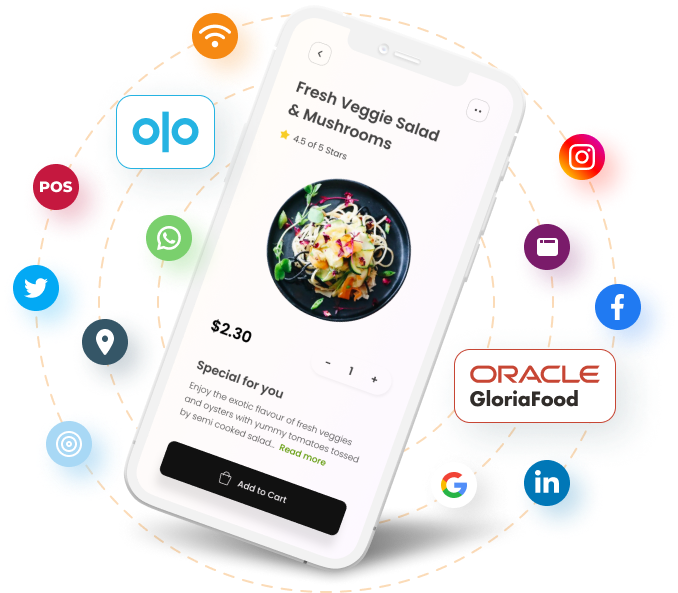
Scroll to explore
A robust and reliable restaurant analytics platform is central to the success of any restaurant business.
Restaurant marketing analytics will help you generate more guests, increase sales, gain insights into guest behavior and preferences, create detailed customer profiles, measure return on investment (ROI), and help maximize those valuable marketing dollars.
Surprisingly, though, most restaurant businesses are still in the dark when it comes to using marketing analytics for business growth purposes and measuring ROI.
For example, a CMO Council survey of senior marketing executives found that “more than 80% of respondents were dissatisfied with their ability to measure marketing ROI,” as reported by the Harvard Business Review.
Brick-and-mortar businesses, like restaurants, have been at even more of a disadvantage because until now, guest data collection has been difficult to collect and very expensive.
However, now there is a low-cost easy way to collect guest data from multiple channels – WiFi logins, online ordering & reservations, POS systems, your website, and more.
Better yet, gathering these restaurant analytics is completely automated, saving you time and resources.
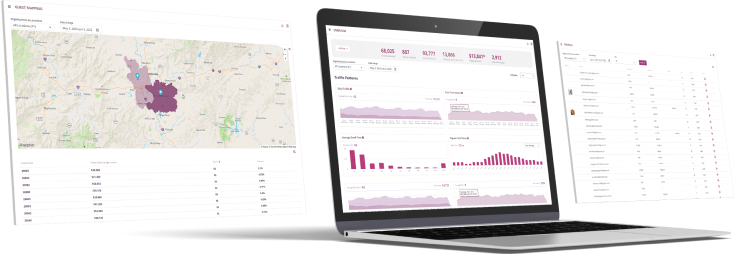
What Are Restaurant Analytics?
Every restaurant business is different, which means marketing analytics will mean something slightly different to each of them.
That said, WordStream provides a rather useful definition:
“Marketing analytics is the practice of measuring, managing, and analyzing marketing performance to maximize its effectiveness and optimize return on investment (ROI). Understanding marketing analytics allows marketers to be more efficient at their jobs and minimize wasted web marketing dollars.”
In addition, according to a recent MarketsandMarkets™ market research report, the WiFi analytics market size is expected to grow from USD 5.3 billion in 2019 to USD 16.8 billion by 2024, at a compound annual growth rate of 26.0% during the forecast period.
Like everything else in marketing, best practices for effectively leveraging restaurant marketing analytics are changing, in part because of new technologies and new data sources that continue to flood the market.
Perhaps the best technology for restaurants to use to gather comprehensive guest demographic and behavior data is a restaurant marketing and customer data platform.
A CDP gathers and stores data from many different sources about your restaurant guests and how they engage with your brand online and how they behave at your place of business.
It stores all of the data and allows you to analyze many different types of restaurant analytics.
Next, we will show you some restaurant analytics examples available in the Bloom Intelligence restaurant customer data platform.
Restaurant Analytics Examples
Perhaps the easiest and most effective way to gather a large amount of analytics data is to utilize a restaurant customer data platform (CDP).
A CDP like Bloom Intelligence collects data from multiple sources and pulls it all together into one centralized database.
This gives you the ability to see specific restaurant analytics from a general overview of your customer base all the way down to individual guests.
Here are some of the analytics you can easily collect using a restaurant CDP.
Daily Traffic and First-Time Visitors
These key performance indicators give you a great view of daily foot traffic. It makes it easy to spot trends of rising or falling guest visits and/or online orders.
Better yet, it allows you to quickly see the results of the restaurant marketing campaigns you are executing. Likewise, it can help you decide where to spend your marketing dollars.
Moreover, the data is collected in real time and can be filtered for any day of the week or time/date span.

Dwell Times and Popular Visit Times
These restaurant analytics are valuable by making it possible to see how long guests are staying at your restaurant and what times they arrive.
By knowing your guest dwell times, you’ll have powerful insight into how guests behave at different times of the day.
For instance, if your average dwell time is 1 hour, but every day at a certain time it dips to only 30 minutes, then you will be able to further investigate why guests are not staying as long – and make data-driven changes to increase their time spent.
The longer guests dwell at your restaurant, the more money they will typically spend.
Knowing your popular visit times will also help you make data-driven marketing, staffing, and purchasing decisions, saving costs of overstaffing or over-purchasing.
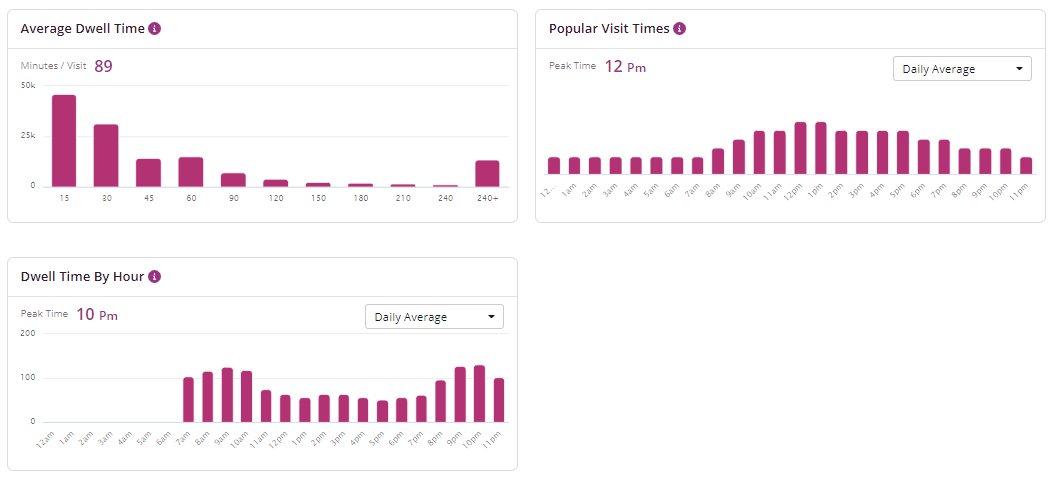
Engagement Analytics
Guest engagement is important for loyalty and reputation management. Engagement metrics include the number of guest profiles created, and by which channel they were created – WiFi login, online order, or website forms.
Engagement analytics also include detailed data on guest ratings and reviews from sites like Google and Facebook, or by direct email surveys.
Being able to see your ratings and reviews from these sites all in one place saves a great deal of time. Likewise, it allows you to easily spot trends or issues that need to be addressed.


Using artificial intelligence, the system also gives you an easy-to-understand word cloud of positive, neutral, and negative customer sentiment.
This is priceless data that your actual guests are giving you, allowing you to make data-driven decisions for your marketing and operations.
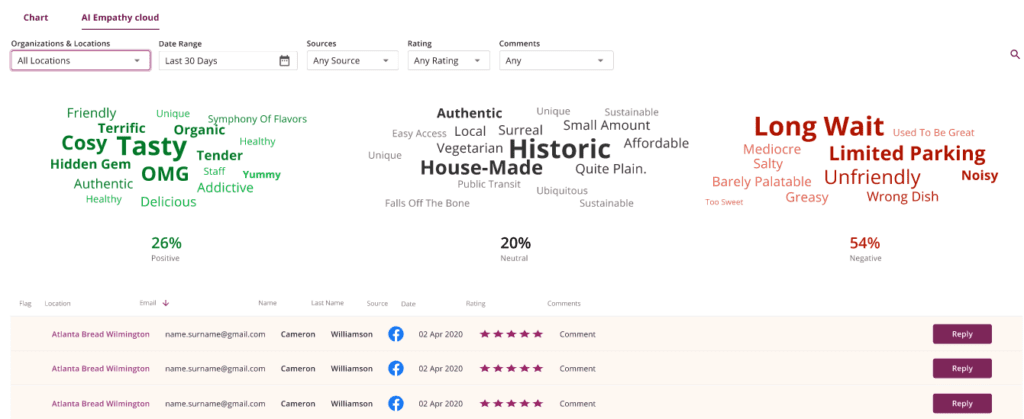
Restaurant Business Analytics
The Bloom Intelligence CDP will also analyze your data and calculate your average guest churn rate and projected guest visits.
By having this real-time data, you can monitor trends in guest loss and make adjustments to your marketing and operations accordingly.
By integrating with your POS system, you will also be able to quickly see your average guest lifetime value and per-person average.

Restaurant Guest and Loyalty Analytics
Regular guests are the lifeblood of any successful restaurant. It is important to keep track of how many of your guests are repeat customers, and how many times they return.
Having these analytics close at hand allows restaurant operators to know where they stand with guest loyalty – and work to improve it.
Your regulars will make or break your bottom line. So, it’s time to understand your loyalty levels and start working to improve them and increase your bottom line.
Gender and age distribution analytics also give you a better understanding of who your guests are so that you can cater your messaging and branding to the right crowd.
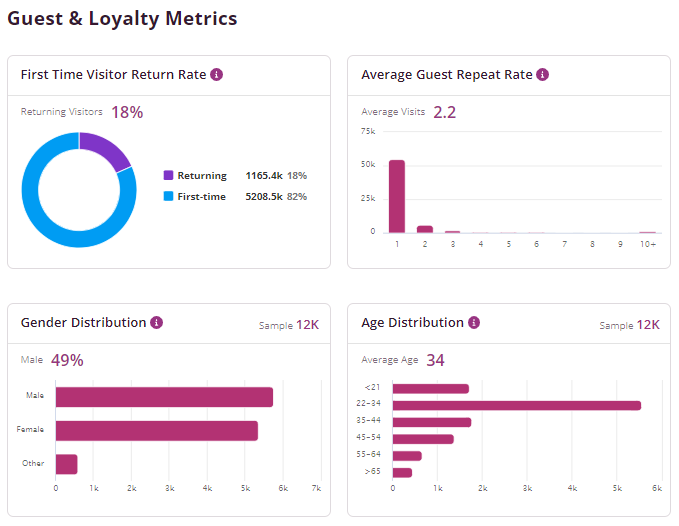
Restaurant Analytics Trends for 2023
Innovative marketers are experimenting with multiple new approaches using guest data and a restaurant CDP, but 4 trends are most likely to be dominant in 2023.
New Data Sources
Until recently, marketing decisions were primarily informed by an analytics approach that relied on large, centralized data warehouses.
Now, marketers are turning to customer data platforms to increase and enhance their understanding of customer behavior.
That means effectively juggling data from traditional sources, as well as new ones, including everything from online ordering platforms, social media sites (especially Facebook, Twitter, and Instagram), reservation systems, online ratings, WiFi marketing solutions, and more.
It also means that restaurant marketers, in addition to analyzing the data, must find those new sources which are most useful to their businesses.
Doing so will help them make more informed decisions, enhance the overall guest experience, improve customer sentiment and drive down costs.
In terms of restaurant marketing data and ROI, a restaurant CDP is possibly the best solution.
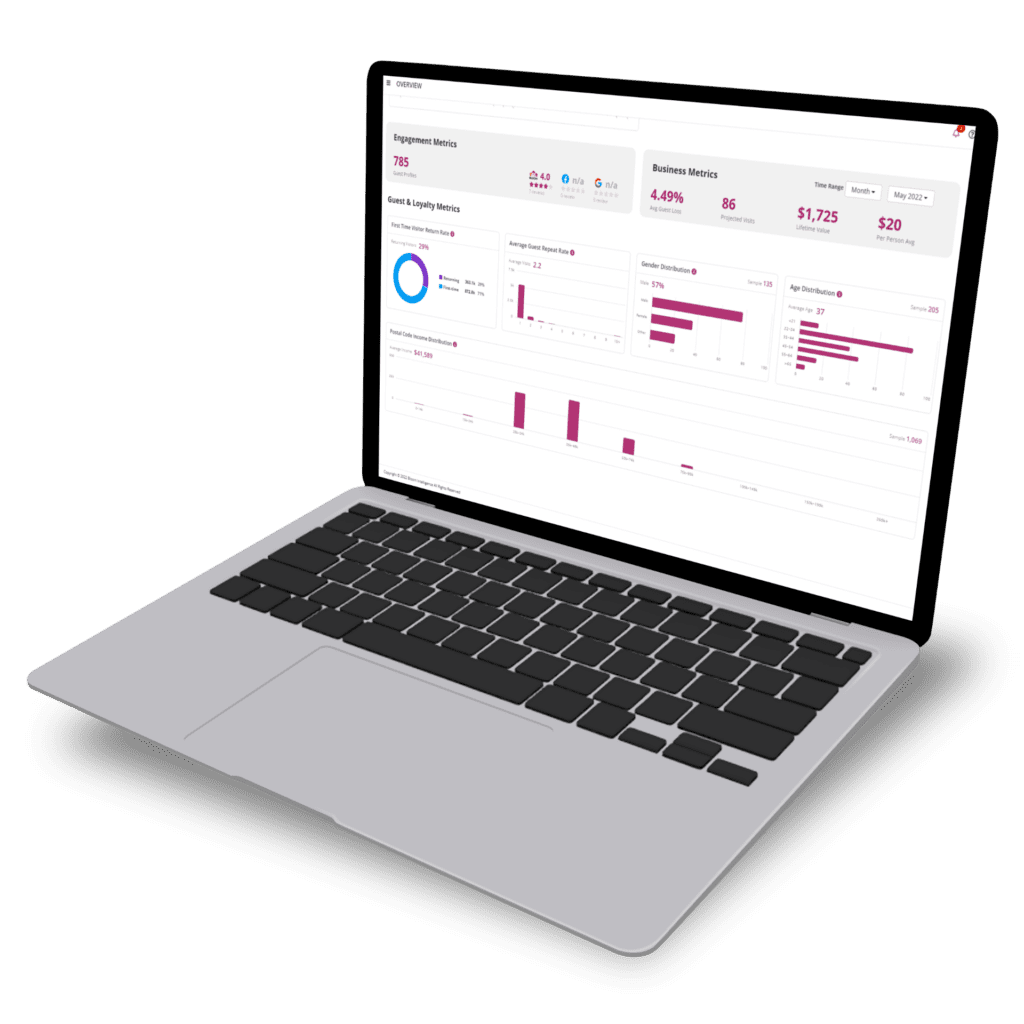
A Push for Restaurant Marketing Analytics
A principal reason for the success of eCommerce businesses is their ability to collect data about their online shoppers.
Brick-and-mortar stores, lacking this capability, have found it very difficult to effectively compete.
However, with the rise of restaurant analytics, this is no longer the case.
Using the various data sources, brick-and-mortar stores can use data to gain valuable insights about on- and off-premise guests, such as how long they stayed, what time they visited or ordered, how much they spend, and whether they are first-time or repeat guests.
You can organize the data to better understand guest behavior and to make operations and marketing decisions that best accommodate that ideal behavior.
So, restaurant customer data platforms essentially level the playing field, allowing brick-and-mortar locations to more easily and accurately measure marketing ROI, improve guest experience, and more effectively withstand the competition.
Artificial Intelligence (AI) Can Do Some Heavy Lifting
The speed of data entering restaurant customer databases is accelerating, making it increasingly difficult for marketers to effectively process it.
For this reason, more businesses are utilizing customer data platforms that include an artificial intelligence (AI) capability.
When effectively leveraged, AI can rapidly identify guest data patterns, sentiments, and trends to provide insight into the best approaches to performance optimization.
With behavior data captured from a CDP, things like customer lifetime value, customer sentiment, and guest churn rate can be identified and dealt with.
For example, you have the ability to automatically reach out to guests who are at risk of not returning and engage them to get them back through your doors.
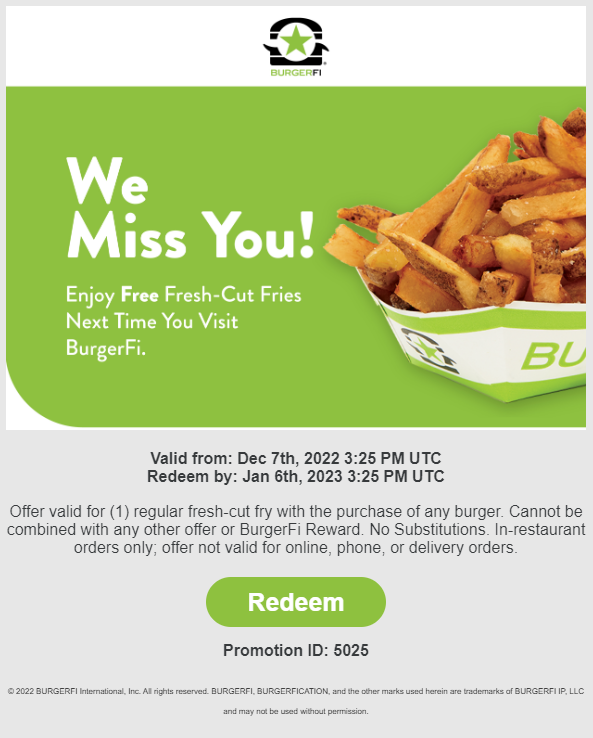
Translating Complex Analytics Into Simple Language
Traditionally, data analysts were expected to crunch numbers and generate reports, but little more.
The problem has been that decision-makers, often lacking experience in some of the more obscure concepts and terminology, haven’t truly understood what those reports were telling them.
Now, analysts will need to provide more context and meaning so decision-makers can effectively use the insights they provide.
That means that providing results in easy-to-understand graphs and charts, and translating results into narratives that key decision-makers can use to more effectively do their jobs is important.
This is something that a restaurant CDP can do for you, at pennies-on-the-dollar compared to traditional data analysis methods.
As new data sources emerge, restaurant marketing continues to evolve, as do the tools marketers use to measure the effectiveness of their activities.
Forward-focused restaurants understand the need to keep pace with these changes to succeed in an increasingly competitive environment.
And a restaurant customer data platform like Bloom Intelligence can help them succeed.
Discover Bloom Intelligence
If you are ready to start building your own powerful restaurant customer data platform, take a look at Bloom Intelligence. By building your own restaurant customer data platform you will take control of your own guest data, and unlock guest insights that will improve the success of your business.
Then, combine this with our unified WiFi marketing automation and reputation management to save time with automation, and money with the consolidation of services into one unified platform and increase your guest lifetime values.
In today’s competitive environment, we can give you the competitive edge for success! Let us show you how.
- Call Click To Call727-877-8181
- Email us at Click To Send An Emailsales@bloomintelligence.com
- Schedule a Demo
SAVE TIME, INCREASE CUSTOMER LIFETIME VALUES, CREATE NEW CUSTOMERS
What our happy customers
are saying
“SaaS that covered so many bases for us instead of having to use multiple software products. Bloom Intelligence has simplified our responses to reviews, customer feedback, and more. I highly recommend Bloom Intelligence.”
Robert Sanderson
“Bloom Intelligence really is a step ahead in terms of marketing software and metrics. Their product is reliable, fast and innovative and has helped the company I work for really grow.”
John Marchetti
“Working with Bloom Intelligence has been amazing. They assist you every step of the way and work with you hand in hand to make sure you are optimizing your advertising potential. We are excited to use this tool to help learn more about our customers so that we can personally engage with them and understand our strengths/weaknesses.”
Ariel Ramirez
“In these challenging times, it has been a pleasure working with Bloom Intelligence to help facilitate our service offering to our clients. They were extremely responsive and provided support to mitigate risk and minimize revenue loss. Great partner!”
Stefan Kim
“We’re extremely pleased with the wealth of customer data that we’re able to gather, at a very attractive price. In addition, we’re able to communicate our new product promotions by using the landing page as a digital billboard. A “no-brainer” for anyone working with limited Marketing $$.”
Bob Cross, Vice President of Operations
Restaurant Analytics FAQs
What Does CDP Stand For?
CDP stands for Customer Data Platform. To summarize, a CRM database is a collection of guest data grouped into customer profiles. So, a CRM can be used to understand your customer base, and for segmented, targeted marketing campaigns that can be tracked for accurate attribution.
What is a CRM Database?
A CRM Database is a digital collection of individual guest information grouped into customer profiles. Likewise, the database consists of detailed guest data such as names, behavior data, demographics, addresses, zip codes, emails, and phone numbers. As a result, these profiles are used to track communication and to remarket to guests.
What are Examples of a CRM Database?
For example, a CRM database for offline companies is the Bloom Intelligence CRM database. For example, using guest WiFi access points & guest WiFi landing pages, the platform collects guest behavior data, whether they log into WiFi or not, and builds detailed customer profiles for marketing and attribution. By comparison, other popular CRM’s include Salesforce, Microsoft Dynamic, and Hubspot.
How Do I Create a CRM Database?
For restaurant and retail locations, the easiest and best way to create a CRM database is to use your WiFi access points, Guest WiFi landing page, website widgets, and API’s to collect guest information and behavior data. Then, once configured, your guest data is collected and cleaned automatically.
The Power of Restaurant Analytics

Optimize retail &
business operations

Track attribution of
customer campaigns

Trigger marketing
campaigns based on
marketing presence

Measure the health
of corporate & franchisee
locations

Compare locations or
group of locations to
quickly identify opportunities
or threats
Are you ready to grow
your business with a
restaurant CDP and
restaurant analytics?
If so, find out how Bloom Intelligence’s restaurant
marketing platform measures offline guest
behavior and builds guest loyalty.
So, it’s time to start leveraging your guest WiFi to gain
a competitive edge. Then watch your profits grow.



